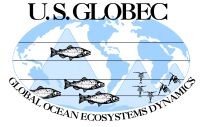
Participants
__________
GLOBEC
International
__________
| GLOBEC Northeast Pacific Program Mapping of Physical and Biological Fields in the Northern California Current July 31 - August 19, 2002 |
 |
August 11, 2002 Station work 8:00 a.m.: Sunny skies greet the Revelle on this Sunday morning. During the early morning hours the ship has performed CTD/rosette casts at five different stations in close proximity to each other. These stations are in-between the north fine scale survey and the south fine scale survey. When the station work is complete, the next task will be to locate the bio-optical drifters that were deployed several days ago. When they are located, additional station work (CTD/rosette, bio-optical profiling, and TSRB) will be done at that location before moving on to the south fine scale survey later this evening. One noteworthy observation can be made about the water color. Near shore over the continental shelf the color of the water is an obvious brown and brown-green color due to the high productivity of the plankton. The factors that influence the productivity of the plankton include the wind driven upwelling of cold nutrient-rich water which is one of the phenomenon being studied on this cruise. Farther offshore in deep waters the water is a crystal blue color indicating an absence of high concentrations of plankton. Update 8:15 a.m.: The bridge reports the drifters have been spotted. Station work will continue in this area as planned. 10:30 a.m.: With the drifters located earlier than expected, plans have changed. Station work has commenced with a CTD/rosette cast, TSRB deployment, and the bio-optical profiler package. Once the station work is done here, plans call for a rendezvous with the New Horizon and the fishing vessel Frosti for additional station work and SeaSOAR towing. Shown below is 3rd mate for the Revelle, Matt Michalski, in control of the ship aided by Renato Castelao who kept an eye on the drifters. Three more drifters will be deployed on Monday. Twenty-four hours before they are released, they are turned on, labeled with return addresses, and checked to make sure the transmitters are working properly. Shown here is Renato preparing the remaining drifters. The graphic shows the paths taken by the three drifters released on the first day of the cruise as well as the paths for the three drifters released August 8. 12:00 p.m.: Station work is almost complete. Amanda Briggs monitors the bio-optics profiler data while the instruments are still in the water. Chad Waluk and Chris Wingard work on repairing the SeaSOAR connectors that were damaged on Saturday. As plans change, the chief scientist posts updates on the white board in the hall outside the labs. Because the science crew is on rotating shifts and meetings would be difficult to have to announce changes in the activities, the white board has become the place to check for the latest information.
Chief Scientist Daily report for 10-11 August 2002
9:00 p.m.: The Revelle makes a close rendezvous with the New Horizon and the Frosti. Using the data from the HTI instrument that uses sound to image particles in the water, Kasey Legaard looks for well defined layers of biomass. The depths of these layers are sent by radio to the New Horizon and the Frosti which will then use sampling nets and target those depths. A clear but cool night afforded excellent views of the Moon and Venus.
|
This page was last updated on August 18, 2002 06:45 AM
.jpg)
.jpg)
.jpg)
.jpg)
.jpg)
.jpg)
.jpg)
.jpg)
.gif)
.jpg)
.jpg)
.jpg)
.jpg)
.jpg)
.jpg)


